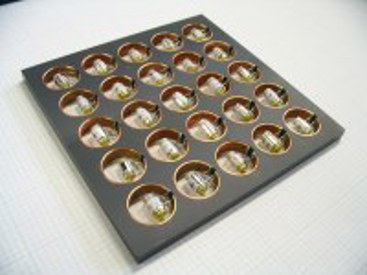Magneto-Inductive Wave Devices
Magneto-Inductive Wave Devices

With an active collaboration between researchers here in Oxford and colleagues at Moscow and Ehrlangen we have been pursuing research in this area since 2000. Magneto-inductive waves are excitations that exist in arrays of inductively coupled resonant circuits.
An example of such an array is shown here in which copper rings cut from a standard water pipe are formed into resonant circuits by cutting a slot lengthways into them and connecting a capacitor across that slot to form an LRC resonator with an open inductor.
Each element of the array can carry a circulating current which couples to it's neighbors. These structures are very well modeled by simple coupled circuit theory if one has a method for determining all the relevant mutual inductances present in the system.
For simple circular resonators the mutual inductance can be quite tricky to compute analytically but there are a number of methods which can produce reasonable results. In general we make use of a dimensionless number, the coupling strength which is twice the ratio of the mutual inductance between two identical resonators and their self inductance (2M/L). Here a plot of the coupling strength between two circular resonators, 22mm in diameter is shown for two cases - one when they are located on a common axis and the other when they are laid adjacent to one another on a flat surface.
Coupling is strongest when the two resonators are practically co-located giving the maximum theoretical value of 2, then falls rapidly as they are moved apart. In the planar case the coupling strength is smaller in magnitude and negative. As the two rings cannot interpenetrate the closes approach is then their separation (r) is equal to their diameter (2a)
An array of such devices, formed by coupling them in a planar fashion will support magneto-inductive waves which are backward waves. Circuit models of such structures enable the dispersion relation for these novel waveguides to be derived. Assuming only the nearest neighbor or coupling is significant (this is a reasonable first approximation) a simple wavelike solution can be derived for an infinite set of resonators with a dispersion given by a simple relationship in terms of the resonant frequency of the elements, their Q factors and their separation r.
Here the propagation constant for the magneto-inductive waves gamma is described in terms of two components a propagation index beta and an attenuation coefficient alpha. For 22mm diameter resonators with 270 pF capacitors soldered across them (generating a resonant frequency of 47MHz with Q=110) the dispersion is plotted here as a function of the coupling strength between the elements in an infinite 1 dimensional line.
As the in-plane coupling rises the attenuation shows an increasingly broad passband - in this example the passband becomes > 10% of the resonant frequency when the in plane coupling is -0.15. The propagation constant is interesting in this case - it shows the present of what are known as backward waves - waves for which the directions of the phase velocity is positive whilst the slope of the dispersion is negative (meaning that the group velocity is negative also).
The planar coupled maneto-inductive waveguide is being studied as a possible method for obtaining contactless data transfer between devices in proximity to it.
